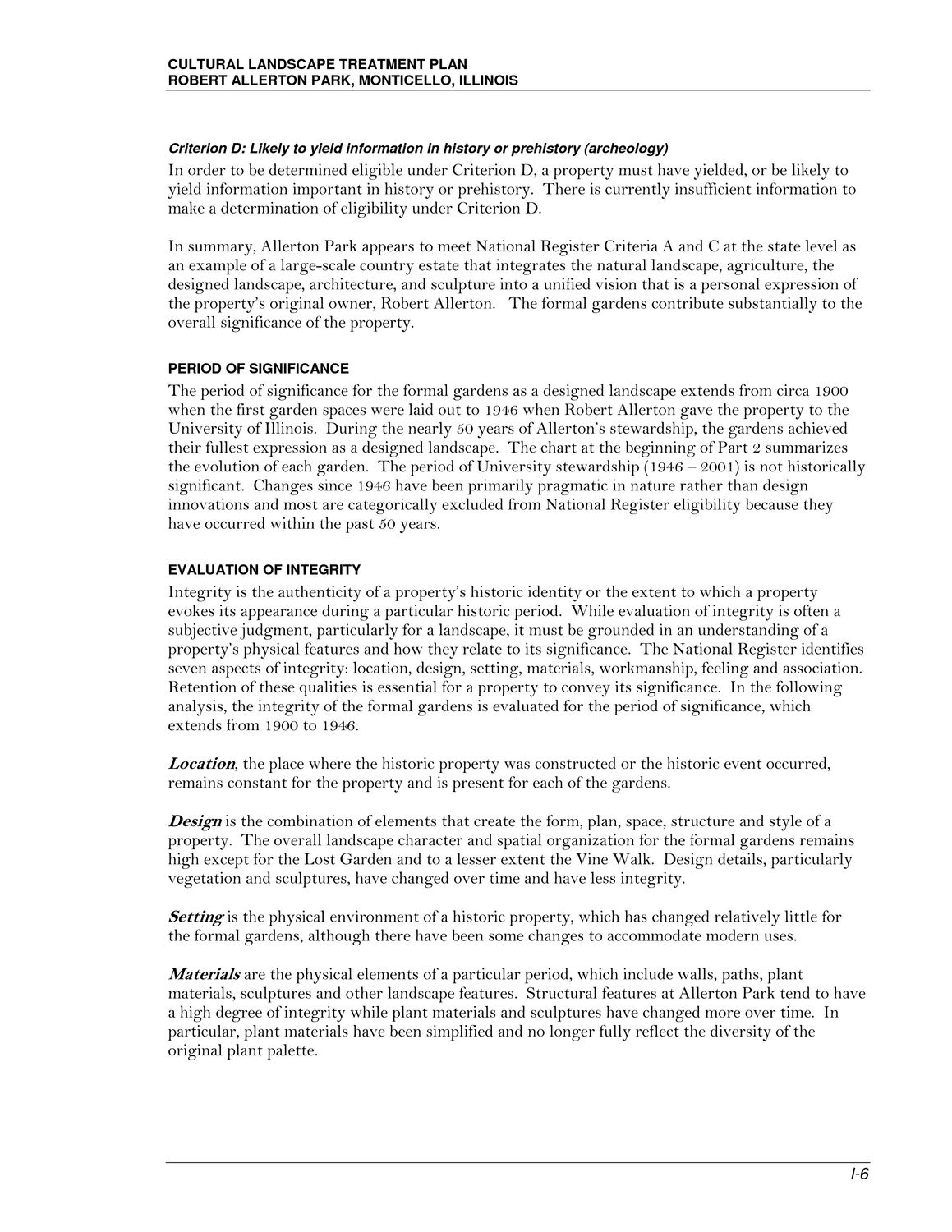| |
| |
Caption: Map of UIUC (2001) (Allerton)
This is a reduced-resolution page image for fast online browsing.

EXTRACTED TEXT FROM PAGE:
CULTURAL LANDSCAPE TREATMENT PLAN ROBERT ALLERTON PARK, MONTICELLO, ILLINOIS Criterion D: Likely to yield information in history or prehistory (archeology) In order to be determined eligible under Criterion D, a property must have yielded, or be likely to yield information important in history or prehistory. There is currently insufficient information to make a determination of eligibility under Criterion D. In summary, Allerton Park appears to meet National Register Criteria A and C at the state level as an example of a large-scale country estate that integrates the natural landscape, agriculture, the designed landscape, architecture, and sculpture into a unified vision that is a personal expression of the property’s original owner, Robert Allerton. The formal gardens contribute substantially to the overall significance of the property. PERIOD OF SIGNIFICANCE The period of significance for the formal gardens as a designed landscape extends from circa 1900 when the first garden spaces were laid out to 1946 when Robert Allerton gave the property to the University of Illinois. During the nearly 50 years of Allerton’s stewardship, the gardens achieved their fullest expression as a designed landscape. The chart at the beginning of Part 2 summarizes the evolution of each garden. The period of University stewardship (1946 – 2001) is not historically significant. Changes since 1946 have been primarily pragmatic in nature rather than design innovations and most are categorically excluded from National Register eligibility because they have occurred within the past 50 years. EVALUATION OF INTEGRITY Integrity is the authenticity of a property’s historic identity or the extent to which a property evokes its appearance during a particular historic period. While evaluation of integrity is often a subjective judgment, particularly for a landscape, it must be grounded in an understanding of a property’s physical features and how they relate to its significance. The National Register identifies seven aspects of integrity: location, design, setting, materials, workmanship, feeling and association. Retention of these qualities is essential for a property to convey its significance. In the following analysis, the integrity of the formal gardens is evaluated for the period of significance, which extends from 1900 to 1946. Location, the place where the historic property was constructed or the historic event occurred, remains constant for the property and is present for each of the gardens. Design is the combination of elements that create the form, plan, space, structure and style of a property. The overall landscape character and spatial organization for the formal gardens remains high except for the Lost Garden and to a lesser extent the Vine Walk. Design details, particularly vegetation and sculptures, have changed over time and have less integrity. Setting is the physical environment of a historic property, which has changed relatively little for the formal gardens, although there have been some changes to accommodate modern uses. Materials are the physical elements of a particular period, which include walls, paths, plant materials, sculptures and other landscape features. Structural features at Allerton Park tend to have a high degree of integrity while plant materials and sculptures have changed more over time. In particular, plant materials have been simplified and no longer fully reflect the diversity of the original plant palette. I-6
| |